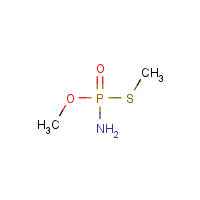Methamidophos
Agent Name
Methamidophos
CAS Number
10265-92-6
Formula
C2-H8-N-O2-P-S
Major Category
Pesticides

Synonyms
Monitor; Nitofol; Tamaron; Swipe; Nuratron; Vetaron; Filitox; Patrole; Tamanox; SRA 5172; Tam; [EXTOXNET] Acephate-met; Amidor; Bayer 5546; CKB 1220; Chevron 9006; Chevron ortho 9006; ENT 27,396; Filitox; Hamidop; MTD; Metamidofos estrella; Metamidophos; Methyl phosphoramidothioate ((MeO)(MeS)P(O)(NH2)); Monitor (insecticide); O,S-Dimethyl phosphoramidothioate; Ortho 9006; Ortho Monitor; Pillaron; RE 9006; Sniper; Tahmabon; Thiophosphorsaeure-O,S-dimethylesteramid [German]; Phosphoramidothioic acid, O,S-dimethyl ester; [ChemIDplus] UN2783
Category
Organophosphate Insecticides
Description
Colorless crystals with a mercaptan-like odor; [HSDB] Colorless to white solid with a strong odor of mercaptans; Formulated as technical/manufacturing use liquid and emulsifiable concentrate end-use-product; [Reference #2]
Sources/Uses
Used to kill insects on broccoli, Brussels sprouts, cauliflower, grapes, celery, sugar beets, cotton, tobacco, and potatoes; [EXTOXNET] Used to control a wide range of insects in potatoes, tomatoes (special local need only), cotton, and alfalfa grown for seed; Used in other countries on strawberries, peppers, and squash; [Reference #2]
Comments
Classified as "highly toxic," it may be used only by certified applicators. [EXTOXNET] A small number of the organophosphates (OPs) can Induce Delayed Neuropathy (OPIDN). OPIDN usually occurs after ingestion and is usually nonoccupational. [Levy, p. 431] An eye irritant; Can be absorbed through skin; A cholinesterase inhibitor that may cause CNS effects (convulsions and respiratory failure) on short-term exposure; Extended or repeated exposure may cause delayed neuropathy; [ICSC] Reports of delayed neuropathy form occupational exposures; [HSDB] Also a metabolite of the OP pesticide acephate; A cholinesterase inhibitor that is one of the most acutely toxic of the OP pesticides; A moderate eye (corneal opacity persisting up to ten days in 2/6 rabbits) and mild skin irritant; Not sensitizing to guinea pig skin; Neuropathology observed in hens but not in rats; [Reference #2] Ranked second in the US for percentage of cases with life-threatening symptoms among occupational Poison Control Center cases; Reproductive studies have shown effects to several parameters at relatively low exposure levels; No evidence of mutagenicity or carcinogenicity; [UNEP DGDs] “The average of two baseline respective cholinesterase activity determinations three days apart, with no exposures to enzyme inhibiting pesticides for at least 30 days, is recommended for each worker prior to exposure to cholinesterase inhibitors because of large inter-individual differences in published baseline values. To be established at least once a year. Removal from workplace exposures is recommended until the cholinesterase activity returns to within 20% of baseline.” [TLVs and BEIs]
Restricted
A restricted use pesticide in the US; Registration for cotton cancelled in 2009 with existing stocks to be used by September 2010; [Reference #2]
Reference Link #1
Biomedical References
Exposure Assessment
BEI
Acetylcholinesterase activity in red blood cells = 70% of individual's baseline; Butylcholinesterase activity in serum or plasma = 60% of individual's baseline; Sample at end of shift; [TLVs and BEIs]
Vapor Pressure
3.5E-05 mm Hg
Lethal Concentration
LC50 (rat) = 162 mg/m3/4hr
Explanatory Notes
The Guide in the Emergency Response Guidebook is for "Organophosphorus pesticide, solid, toxic."
Reference Link #2
Adverse Effects
Neurotoxin
Predominantly motor
Other Poison
Organophosphate
Diseases, Processes, and Activities Linked to This Agent
Diseases
Occupational diseases associated with exposure to this agent:
Processes
Industrial Processes with risk of exposure: